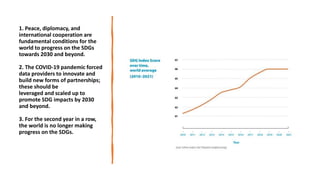
SNB.pptx
- 1. 1. Peace, diplomacy, and international cooperation are fundamental conditions for the world to progress on the SDGs towards 2030 and beyond. 2. The COVID-19 pandemic forced data providers to innovate and build new forms of partnerships; these should be leveraged and scaled up to promote SDG impacts by 2030 and beyond. 3. For the second year in a row, the world is no longer making progress on the SDGs.
- 2. 4. A global plan to finance the SDGs is needed. First, the G20 should declare clearly and unequivocally its commitment to channel far larger flows of financing to developing countries so that they can achieve economic development and meet the SDG targets. Second, the G20 should greatly increase the lending capacity and annual flows of the Multilateral Development Banks (MDBs), mainly through greater paid-in capital to these institutions, but also through greater leverage of their balance sheets. Third, the G20 should support other measures as well – notably increased ODA, large-scale philanthropy, and refinancing of debts falling due – to bolster SDG finance for the LICs and LMICs. Fourth, the IMF and the credit-rating agencies need to redesign the assessments of debt sustainability, taking into account the growth potential of developing countries and their need for far larger 0capital accumulation. Fifth, working together with the IMF and the MDBs, developing countries need to strengthen their debt management and creditworthiness by integrating their borrowing policies with tax policies, export policies, and liquidity management, all to prevent future liquidity crises.
- 3. 5. Rich countries generate negative international spillovers notably through unsustainable consumption; Europe is taking actions. 6. At mid-point on the way to 2030, policy efforts and commitments supporting the SDGs vary significantly across countries, including among G20 countries.
- 4. Annex Methods Summary and Data Tables • A.1 Interpreting the SDG Index and Dashboards results. • A.2 Changes to the 2022 edition and main limitations. • A.3 Methodology (overview) A. Data selection. B. Missing data and imputations. C. Method for constructing the SDG Index and Dashboards